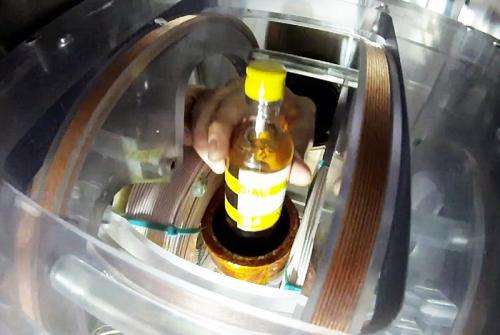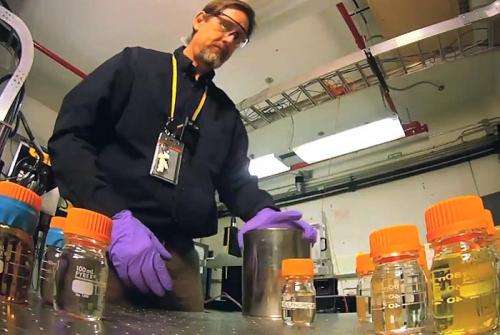MRI breakthrough for screening liquids

(Phys.org) —Los Alamos scientists have advanced a Magnetic Resonance Imaging (MRI) technology that may provide a breakthrough for screening liquids at airport security. They've added low-power X-ray data to the mix, and as a result have unlocked a new detection technology. Funded in part by the Department of Homeland Security's Science and Technology Directorate, the new system is named MagRay.
The goal is to quickly and accurately distinguish between liquids that visually appear identical. For example, what appears to be a bottle of white wine could potentially be nitromethane, a liquid that could be used to make an explosive. Both are clear liquids, One would be perfectly safe on a commercial aircraft, the other would be strictly prohibited. How to tell them apart quickly without error at an airport security area is the focus of Michelle Espy, Larry Schultz and their team.
"One of the challenges for the screening of liquids in an airport is that, while traditional X-ray based baggage scanners provide high throughput with good resolution of some threats, there is limited sensitivity and selectivity for liquid discrimination," said Espy, a Los Alamos National Laboratory physicist and MagRay Project Leader. "While MRI can differentiate liquids, there are a certain class of explosives, those that are complex, homemade, or may have mixes of all kinds of stuff that are more challenging."
In a new video, Espy and the MagRay team explain how the new technology works, how they've developed an easy operator interface, and what the next steps might be in transitioning this technology to the private sector.
"I am amazed at how good it works," said Espy. "We've been able to look at a really broad class of explosives, we've been able to look through all kinds of packaging, and we've unlocked a new parameter – proton content – that's not available to either X-ray or MRI alone."

"We're looking for where a liquid lies in a sort of three-dimensional space of MRI, proton content, and X-ray density," said Schultz, MagRay engineer. "With those measures we find that benign liquids and threat liquids separate real nicely in this space, so we can detect them quickly with a very high level of confidence."
Provided by Los Alamos National Laboratory




















